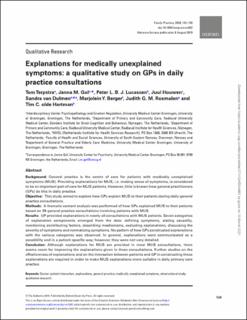| dc.contributor.author | Terpstra, Tom | |
| dc.contributor.author | Gol, Janna M | |
| dc.contributor.author | Lucassen, Peter | |
| dc.contributor.author | Houwen, Juul | |
| dc.contributor.author | van Dulmen, Sandra | |
| dc.contributor.author | Berger, Marjolein Y | |
| dc.contributor.author | Rosmalen, Judith G. M | |
| dc.contributor.author | olde Hartman, Tim C. | |
| dc.date.accessioned | 2021-03-25T10:47:22Z | |
| dc.date.available | 2021-03-25T10:47:22Z | |
| dc.date.created | 2021-01-27T21:50:49Z | |
| dc.date.issued | 2020 | |
| dc.identifier.citation | Terpstra, T., Gol, J. M., Lucassen, P. L., Houwen, J., van Dulmen, S., Berger, M. Y., ... & olde Hartman, T. C. (2020). Explanations for medically unexplained symptoms: a qualitative study on GPs in daily practice consultations. Family practice, 37(1). | en_US |
| dc.identifier.issn | 0263-2136 | |
| dc.identifier.uri | https://hdl.handle.net/11250/2735491 | |
| dc.description.abstract | Background: General practice is the centre of care for patients with medically unexplained symptoms (MUS). Providing explanations for MUS, i.e. making sense of symptoms, is considered to be an important part of care for MUS patients. However, little is known how general practitioners (GPs) do this in daily practice. Objective: This study aimed to explore how GPs explain MUS to their patients during daily general practice consultations. Methods: A thematic content analysis was performed of how GPs explained MUS to their patients based on 39 general practice consultations involving patients with MUS. Results: GP provided explanations in nearly all consultations with MUS patients. Seven categories of explanation components emerged from the data: defining symptoms, stating causality, mentioning contributing factors, describing mechanisms, excluding explanations, discussing the severity of symptoms and normalizing symptoms. No pattern of how GPs constructed explanations with the various categories was observed. In general, explanations were communicated as a possibility and in a patient-specific way; however, they were not very detailed. Conclusion: Although explanations for MUS are provided in most MUS consultations, there seems room for improving the explanations given in these consultations. Further studies on the effectiveness of explanations and on the interaction between patients and GP in constructing these explanations are required in order to make MUS explanations more suitable in daily primary care practice. | en_US |
| dc.language.iso | eng | en_US |
| dc.rights | Navngivelse-Ikkekommersiell 4.0 Internasjonal | * |
| dc.rights.uri | http://creativecommons.org/licenses/by-nc/4.0/deed.no | * |
| dc.title | Explanations for medically unexplained symptoms: A qualitative study on GPs in daily practice consultations | en_US |
| dc.type | Peer reviewed | en_US |
| dc.type | Journal article | en_US |
| dc.description.version | publishedVersion | en_US |
| dc.rights.holder | © The Author(s). | en_US |
| dc.source.pagenumber | 124-130 | en_US |
| dc.source.volume | 37 | en_US |
| dc.source.journal | Family Practice | en_US |
| dc.source.issue | 1 | en_US |
| dc.identifier.doi | https://doi.org/10.1093/fampra/cmz032 | |
| dc.identifier.cristin | 1880800 | |
| cristin.ispublished | true | |
| cristin.fulltext | original | |
| cristin.qualitycode | 2 | |

